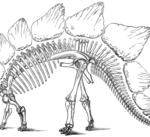 I love Dino. He’s the best dinosaur-dog ever. When Fred Flintstone comes home to Dino’s puppy-dog greeting of jumping into his arms, knocking him down and licking Fred’s face, well, that’s man’s best friend at his best. We’d all love to have a Dino like that except that Dino is a fictional Snorkasaurus which was apparently modeled on a generic Sauropod/Prosauropod type although another Wikipedia site credits Dino as being inspired from the dinosaur Europasaurus which is also a Sauropod.
I love Dino. He’s the best dinosaur-dog ever. When Fred Flintstone comes home to Dino’s puppy-dog greeting of jumping into his arms, knocking him down and licking Fred’s face, well, that’s man’s best friend at his best. We’d all love to have a Dino like that except that Dino is a fictional Snorkasaurus which was apparently modeled on a generic Sauropod/Prosauropod type although another Wikipedia site credits Dino as being inspired from the dinosaur Europasaurus which is also a Sauropod.

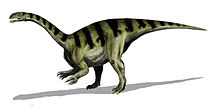
The Sauropod was given it’s name by Marsh in 1878, while the Prosauropod (Plateosauridae) was named, also by Marsh, in 1895. Why is this important? Because Marsh was a principle character in the Bone Wars.
The issue of whether the dinosaurs we learned about as children is not just about the liberties taken in the creation of fictional works . The issue is about whether early paleontologists got it right at all.
In the mid to late 1800s, there was a period of intense rivalry between two paleontologists, Othniel Charles Marsh and Edward Drinker Cope to out-do each other. This period is known as the Great Dinosaur Rush and the Bone Wars. By the end of the Bone Wars, Cope and Marsh were both financially and socially ruined. In their efforts to out-compete each other, they resorted to theft, bribery and they destroyed fossil sites. They even attacked each other in scientific publications.


Cope’s and Marsh’s discoveries were accompanied by accusations of spying, stealing workers and fossils, and bribery. The two men were so protective of their digging sites that they would destroy or damage fossils to prevent them from falling into their rival’s hands, or fill in their excavations with dirt and rock.(Source) Their wars went public, even so far as to be published in the New York Herald. Although their public rivalry popularized 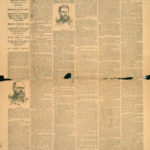 and romanticized dinosaurs, the scientific community had had enough. In June 1873, The American Naturalist stopped publishing their articles when their dispute became too personal because of their respective accusations, defenses, and taunts. Here is part of the statement made by the editors of the American Naturalist:
and romanticized dinosaurs, the scientific community had had enough. In June 1873, The American Naturalist stopped publishing their articles when their dispute became too personal because of their respective accusations, defenses, and taunts. Here is part of the statement made by the editors of the American Naturalist:
WE regret that Professors Marsh and Cope have considered it necessary to carry their controversy to the extent that they have. Wishing to maintain the perfect independence of the NATURALIST in all matters involving scientific criticism, we have allowed both parties to have their full say, but feeling that now the controversy between the authors in question has come to be a personal one and that the NATURALIST is not called upon to devote further space to its consideration, the continuance of the subject will be allowed only in the form of an appendix at the expense of the author. (Source)
What does this mean about what we know of dinosaurs?
Although they discovered over 142 species of dinosaurs, only 32 are valid today. Marsh’s and Cope’s antics harmed the reputation of American paleontology in Europe. Their haphazard assembly of bones and their descriptions of new species, based on their reconstructions, led to confusion and misconceptions that lasted for decades after their deaths.
Here are three examples of what they got wrong:
In 1877, Marsh described and named the Stegosaurus, and illustrated it in 1896.
This abridged excerpt from DinoGoss explains what is wrong and how it was subsequently changed:
Marsh drew a generic Stegosaurus species as an arch-backed quadruped with only a single row of plates protruding vertically along both the back and tail. In 1910, R.S. decided that a double row of paired plates was correct, and that the plates were relatively widely spaced, above the top of the rib cage. This interpretation of Stegosaurus is probably the most famous, and the one that found its way into mid-20th century pop culture. Charles W. Gilmore revised this interpretation only a few years later for an alternating, rather than paired, double row of plates, situated close together on the spine. This interpretation was used in several mid-20th century mounted skeletons.
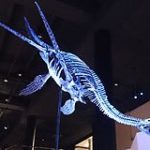
Cope’s most notable mistake was to put the head on the tail when he reconstructed the plesiosaur Elasmosaurus. His reconstruction also lacked hind legs. To cover up his mistake, he bought every copy he could find of the journal it was published in.
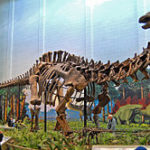
Marsh also put the wrong skull on a skeleton of Apatosaurus and declared it a new genus, Brontosaurus.
To learn more about the Bone Wars read here and here. There are excellent references for books on the subject. For more information about the evolution of our understanding of the stegosaurus, check out DinoGoss. Look here for a full list of fictional dinosaurs.
Thank you to all the folks contributing to Wikipedia for their research and photos.

